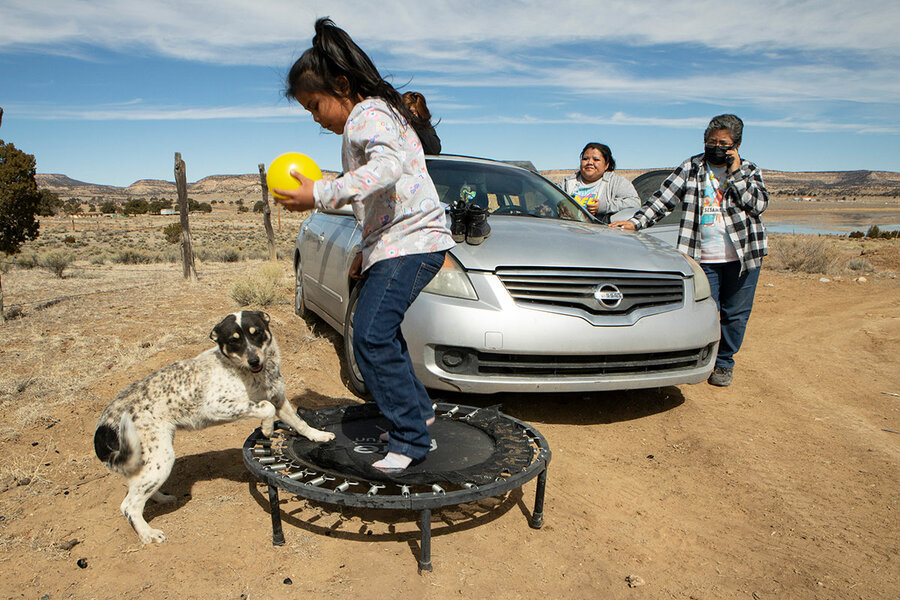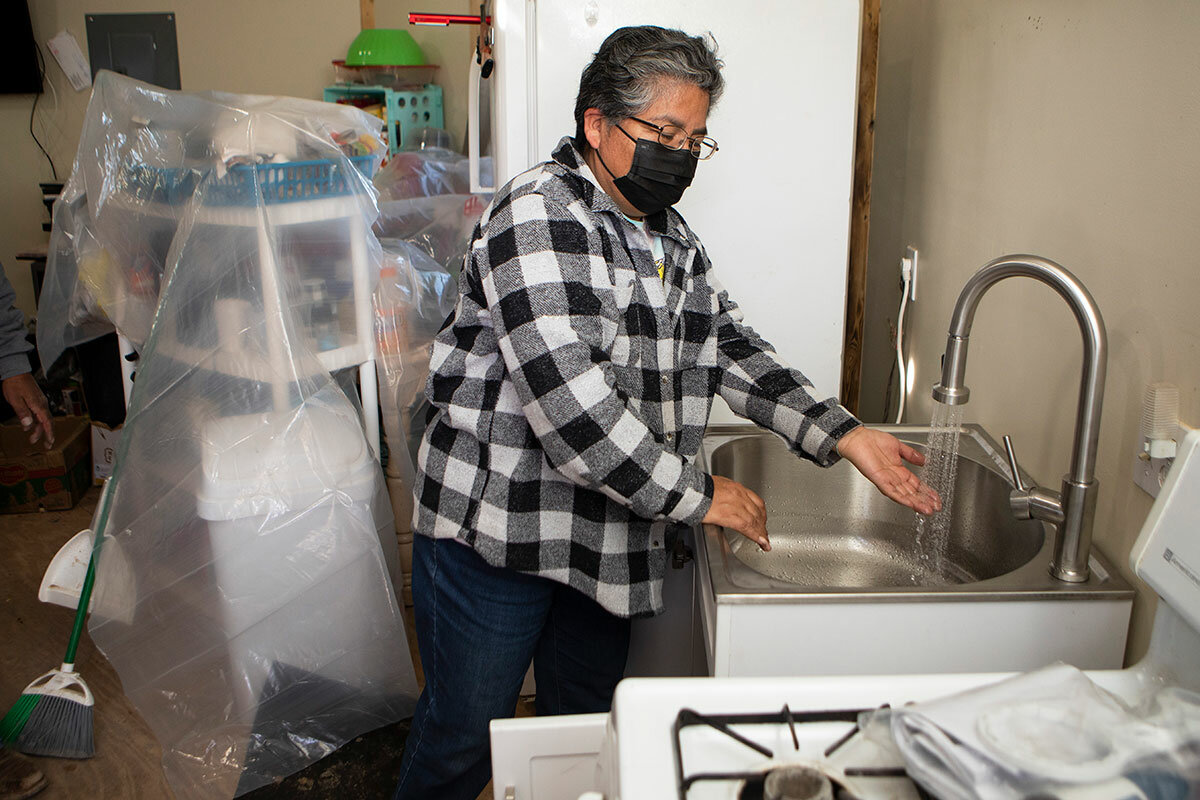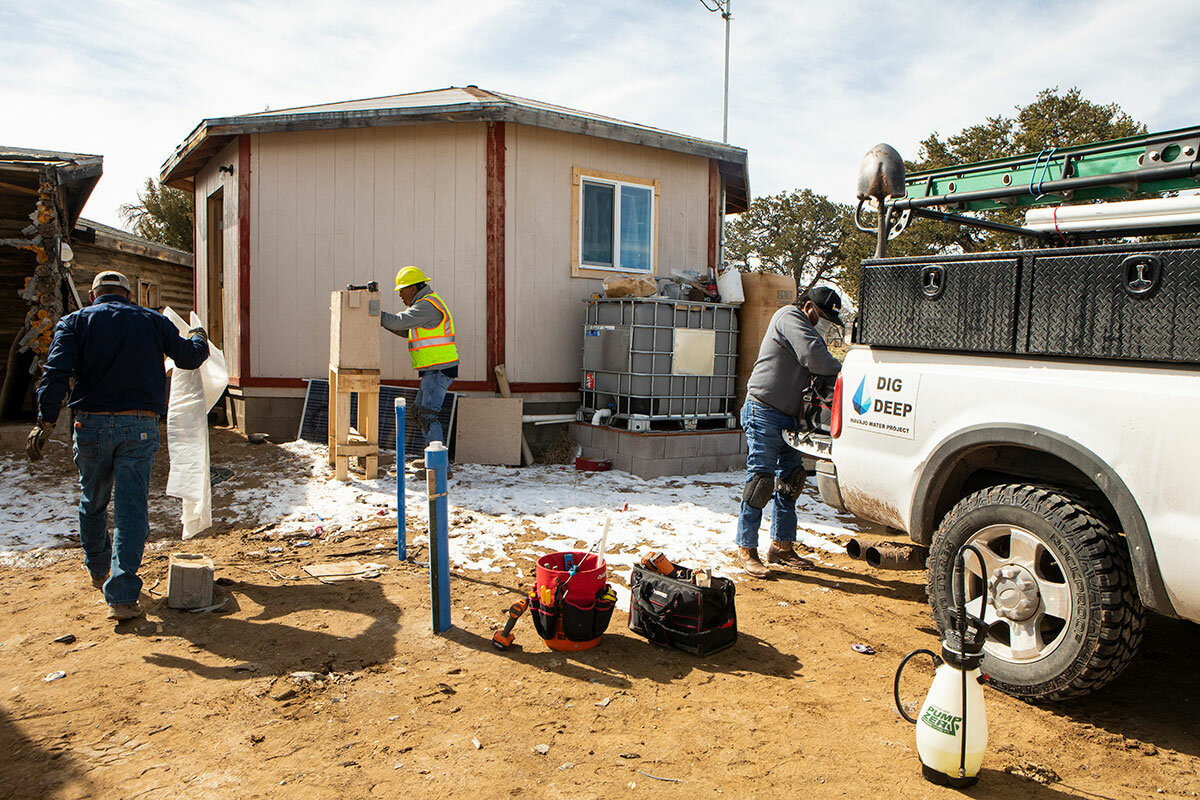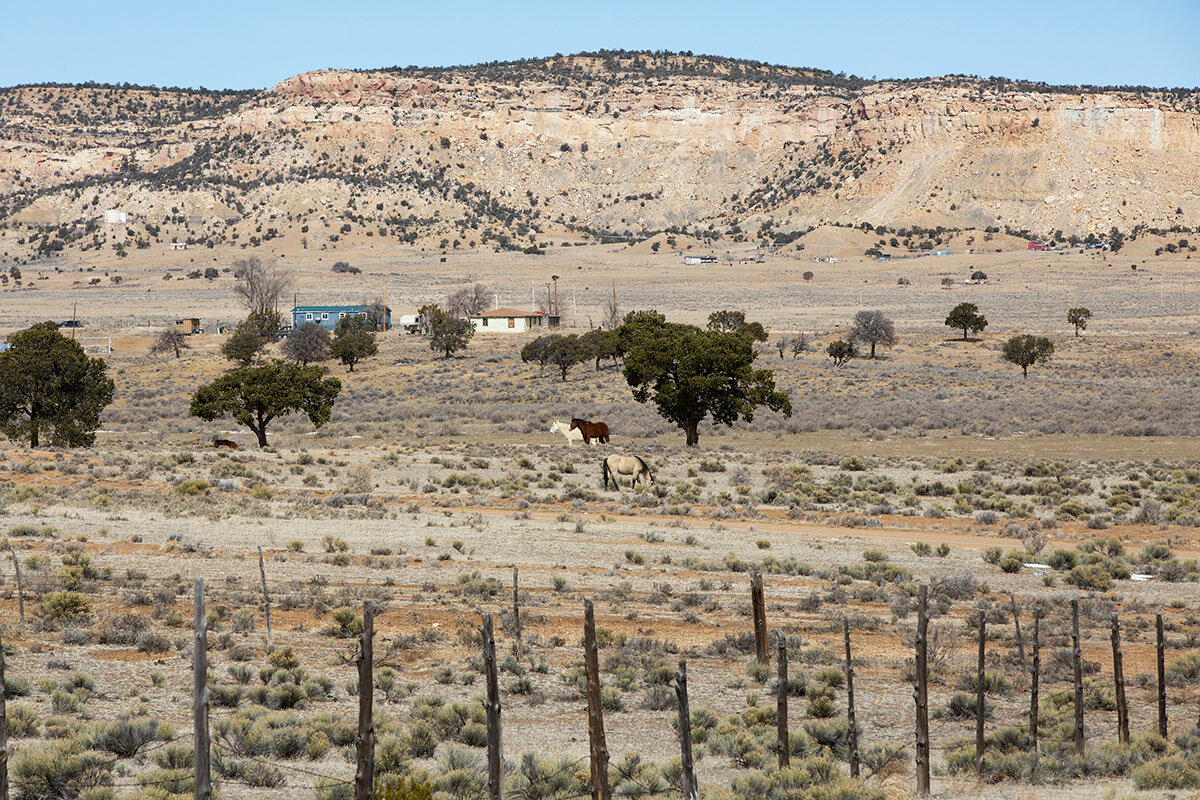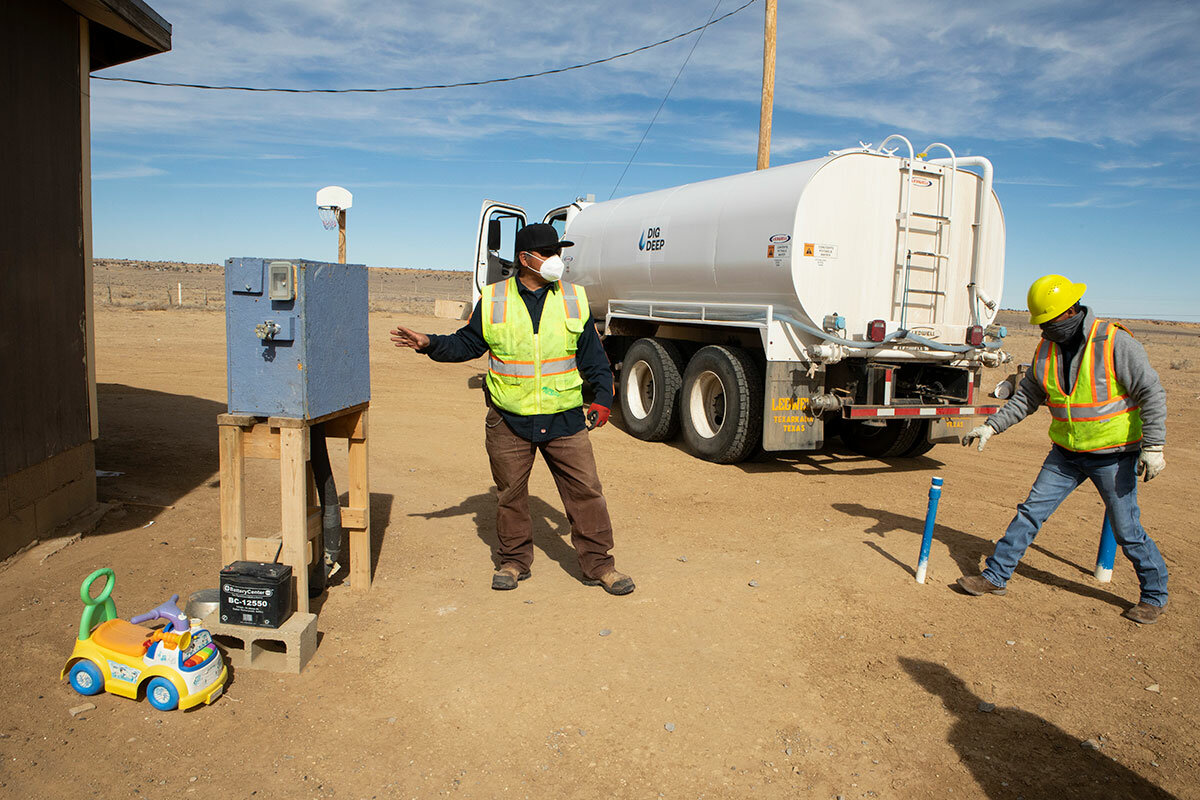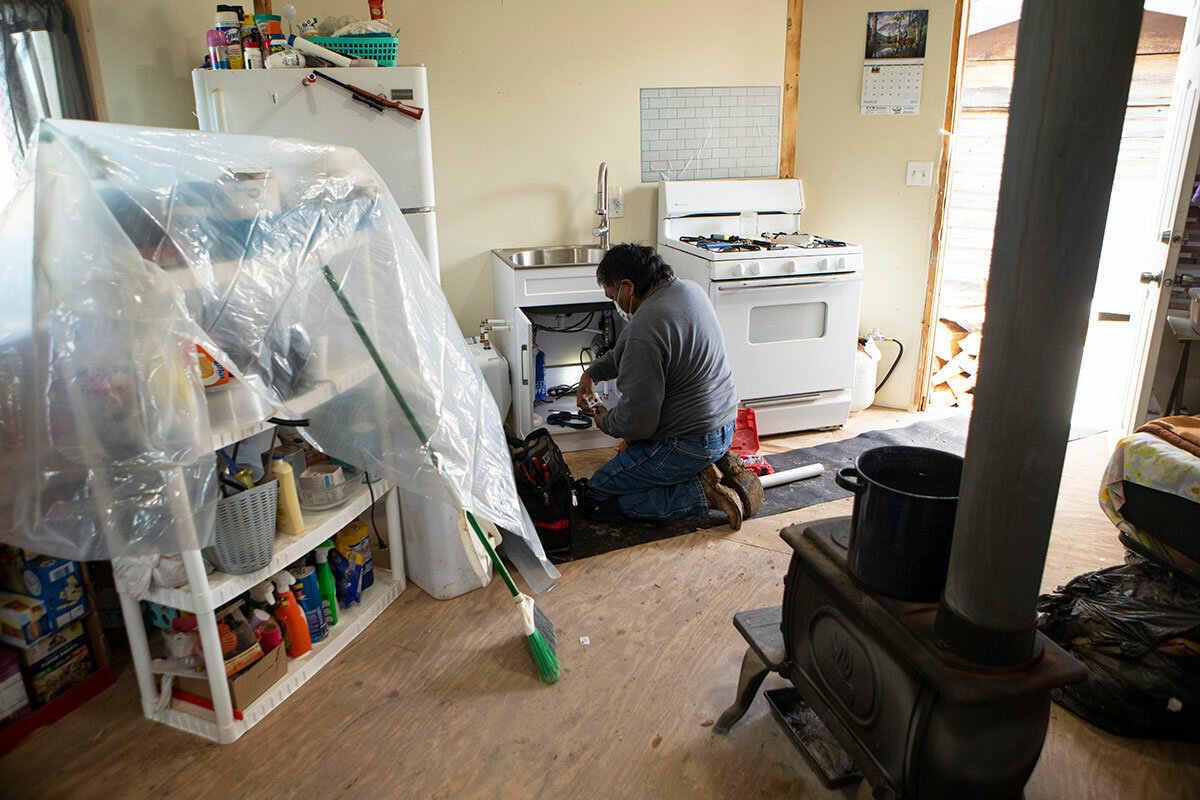How Navajo are turning on taps – even in remote, dry areas
Loading...
| Smith Lake, N.M.
Ida Joe flinches a little as the tap sputters, then spurts water into the sink. Cautiously, tentatively, she pushes her hand under the faucet. She feels the water soak her skin and run through her fingers – first cold, then hot. After a few seconds, she starts to laugh.
Outside the one-room house she shares with her two daughters and granddaughter, a cold breeze rolls across the dusty, arid plains of the Navajo Nation. A few hundred yards away, wild horses drink from a small, briny lake.
Ms. Joe has lived on the Navajo Nation for all of her nearly 50 years. This late February day is her first with running water in her home. Until now, her family would drive to Thoreau, 10 minutes away, or Gallup, 45 minutes away, to buy gallon jugs of water. They would drive to town to do laundry, and rent a hotel room for the day to use the shower.
Why We Wrote This
The Navajo Nation suffered some of North America’s severest pandemic losses. But the pandemic also highlighted the huge number of residents who lack running water – and is helping spur ingenuity-based solutions.
“It will be really helpful, especially for cooking,” she says.
Water is sacred on the Navajo Nation, and scarce. About 30% of the roughly 173,000 population lack running water, according to a report from the U.S. Water Alliance and DigDeep, an international nonprofit with Navajo employees who have been installing running water systems in homes on the reservation since 2014. The size of the reservation, the large distances between homes, scarce natural water sources, jurisdictional issues, and contamination from industries like uranium mines have all contributed to restricting access to running water here for generations.
But according to those working to improve water access on the reservation, the COVID-19 pandemic has heralded a bittersweet turning point.
Almost 1,700 people have died from the virus, according to the tribe, and in mid-2020 the reservation had the highest per capita infection rate in the country. At the same time, the pandemic drew widespread attention to the fact that many Navajo didn’t have enough water to thoroughly wash their hands, which was core advice of health experts at the time. From locals who had accepted they would need to live without running water, to members of Congress, the need to improve water access became crystal clear.
And the pandemic has spurred progress. New coalitions have formed, funding has increased, and innovations from organizations like DigDeep have helped expand water access here more than ever before.
“This has been a silver lining for us,” says Crystal Tulley-Cordova, principal hydrologist for the Navajo Nation Department of Water Resources.
“I’m hopeful for the future,” she adds. The pandemic “has brought different partnerships, and one of the things that I know is that we can do more together.”
A pickup, a backhoe, and “Big Ernie”
A pickup truck, a trailer towing a backhoe, and a gleaming white water truck nicknamed “Big Ernie” make up the DigDeep convoy.
Driving north from Thoreau on Route 371 on that crisp late February morning, the five-man convoy passes through a rugged, beautiful landscape of snow-pocketed mountainsides and dusty flatlands. Arroyos and creeks slash through the terrain – all dry, except for some that hold patches of snow.
At over 27,000 square miles, the Navajo Nation is larger than the state of West Virginia, extending into the states of New Mexico, Arizona, Colorado, and Utah. Like much of the Southwest, the reservation has always had an arid climate, but water has become increasingly scarce.
The region has been in various forms of drought for over 20 years, and is currently experiencing severe and extreme drought, according to the U.S. Drought Monitor. Most of the local water supply is in groundwater, and that has been dwindling. In Gallup, groundwater levels dropped about 200 feet in the 2010s, the city reported in 2018. Snowfall levels have consistently decreased since the 1930s, according to Indian Country Today.
There are also problems with water quality. Arsenic and uranium, both left over from a century of mining on the reservation, are found at dangerously high concentrations in local water sources. (Some arsenic is naturally occurring in the region’s geology.)
Legal barriers and bureaucracy are another challenge. In many areas of the country, tribes have robust water rights through the federal government’s trust obligation toward them. But it’s only in the past few years that the Navajo Nation has gained rights to major nearby water sources such as the Colorado and San Juan rivers. Meanwhile, piping water onto the reservation is challenging because of how spread out the population is. Some areas are a checkerboard of public and private land, presenting right-of-way issues.
On top of that, funding has typically been limited, according to Capt. David Harvey, deputy director of the Division of Sanitation Facilities Construction at the federal government’s Indian Health Service.
“These conditions result in a high unit cost to construct and to operate [sanitation] facilities to serve these remote home locations,” says Captain Harvey. “Historically the funds that have been appropriated have not met the total need.”
In the 2020 fiscal year, for example, the Indian Health Service identified over $3 billion in sanitation facility needs on Native American lands. Congress that year appropriated $197 million. But the response during the pandemic has begun to close that gap.
Through the CARES Act – a pandemic relief funding package passed by Congress in March 2020 – the Navajo Nation received over $5 million specifically for increasing water access on the reservation. Democratic Sens. Michael Bennet and Martin Heinrich, of Colorado and New Mexico respectively, also introduced a bill last year that would provide about $6.7 billion for tribal water infrastructure.
And as federal money has begun to flow toward the problem, new partnerships have formed to identify how those funds should be spent. The pandemic also saw the creation of the Navajo Nation COVID-19 Water Access Coordination Group, a coalition of almost two dozen Navajo Nation and federal government agencies, universities, and nongovernmental organizations.
In the eyes of Dr. Tulley-Cordova, it’s a shift from centuries of hostile and paternalistic attitudes that the U.S. government displayed toward the Diné, as many members of the Navajo Nation prefer to be known.
From their forced relocation in the 1860s, to their attempted assimilation through Native American boarding schools, to the recent, relative indifference toward poor conditions on the reservation, there’s long been a mentality of “we know what’s best for you ... and we don’t really care what you have to say,” she says.
“Now, fast forward a couple of decades. We have the opportunity to be able to say what’s best for us, and be a part of that process,” she adds.
A “suitcase” packed with water tech
The DigDeep convoy has one scheduled stop before Ida Joe’s home. The trucks and trailers roll onto a dusty property just off Route 371, 25 miles north of Thoreau. Bikes, toys, trash, and a basketball hoop sit outside the hogan – a traditional one-room Navajo home, the door facing the rising sun to the east.
The crew were here 18 months ago to install one of their foremost pandemic-era innovations: a “suitcase” – a 4-cubic-foot box filled with a water pump, heater, filter, expansion tank, and battery installed outside homes to provide tap water from a 1,200-gallon underground tank. (DigDeep periodically refills these tanks throughout the year.) The group had been providing the indoor water systems for years, and this invention allowed installation of the systems outside, without workers entering homes.
During the pandemic, 100 of these suitcase systems have been installed by DigDeep crews on Navajo lands, at no cost to residents.
“People [were being told], ‘Wash your hands for at least 20 seconds with soap and water.’ But how can they do that if they don’t have running water?” says Cindy Howe, the project manager for DigDeep’s New Mexico office.
“We had to put our brains into gear.”
Today the crew is replacing the suitcase with an indoor sink. The system will be protected from the elements, and the family won’t have to go outside to get running water.
But the homeowner isn’t here this morning. A crew member calls, but there’s no answer. So they top off the 1,200-gallon tank, replace the filter in the suitcase, which had cracked after freezing during a frigid desert night, and head for Ms. Joe’s home back down Route 371.
There, the crew members work with practiced ease and efficiency, talking interchangeably in English and Navajo. Ms. Joe and her family wait in their car while Kenneth Chavez and Brian Johnson assemble the sink and Erving Spencer maneuvers the backhoe.
The backhoe work is delicate. First, Mr. Spencer has to dig out the suitcase system, bringing the metal teeth of the digger precariously close to the house itself. It looks like trying to perform a Mozart sonata wearing mittens, but he does it expertly.
But after a couple of hours they hit a snag. Specifically, they hit a thick layer of ice. The trench Mr. Spencer is digging – to lay a leach line that will pipe wastewater from the sink out and into the earth – needs to be 3 feet deep, below the freezing level. But he’s hit the freezing level.
So while Mr. Spencer pries blocks of mud-covered ice from the ground, Mr. Chavez installs the sink inside. A small table just inside the door holds an even smaller plastic tub, along with shampoo and conditioner. A towel and a small mirror hang on the wall above it, and four 3-liter water jugs – all empty – sit on a nearby bed. A wood stove in the middle of the room pipes smoke through a chimney into the blue sky overhead.
Ms. Joe likes living here, she says. She feels safe, and she wants to raise her kids and grandkids here.
“It’s one of the most important things that I would probably want to do before I go,” she says, “teaching them the foundation of our culture.”
But living and working on the Navajo Nation has come at an especially high risk in the past two years.
Ms. Joe lost two of her sisters to illnesses complicated by COVID-19, she says. Dr. Tulley-Cordova lost six family members to the virus between December 2020 and January 2021. “Big Ernie,” the DigDeep water truck, is named after Ernest Largo, an employee who died early in the pandemic.
As they finish their work at Ms. Joe’s house, “Big Ernie” refills the 1,200-gallon tank that now supplies her indoor sink. Though he’s gone, it feels to the DigDeep crew like Mr. Largo is still bringing water to homes across the reservation.
Lacking water “is just normal for a lot of people,” says Ms. Howe of DigDeep. Her grandparents would melt snow for water. Her parents hauled water throughout her childhood as well – always on Sundays, so she could have a bath before school on Monday.
“It was really heartbreaking to see,” she says. “Fifty-five years later, it’s still happening.”
“We’re all helping each other,” she adds. But “there’s still a lot of people that don’t have any water.”




